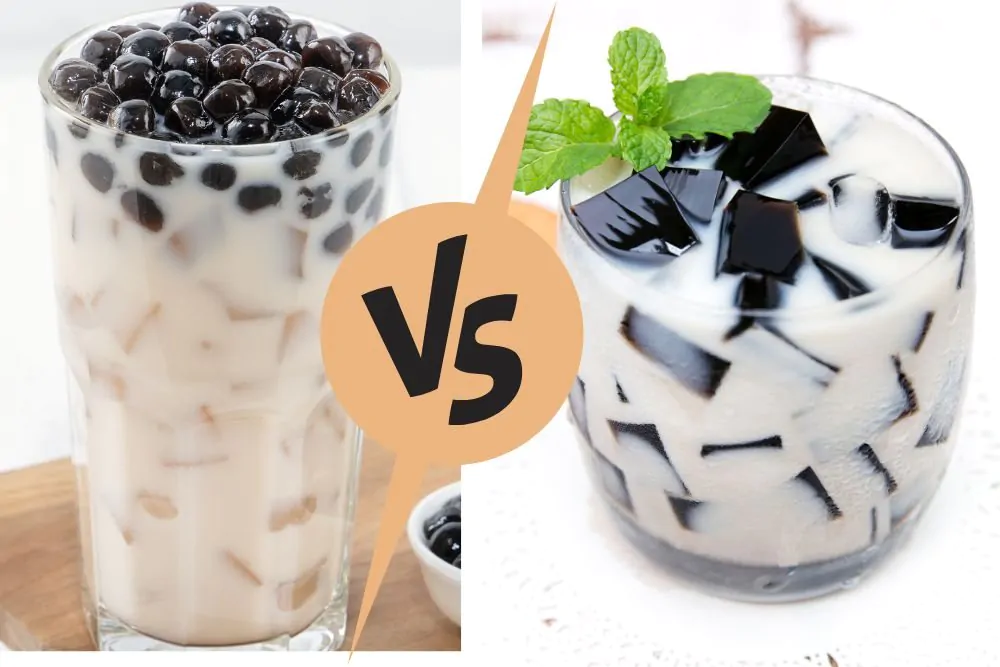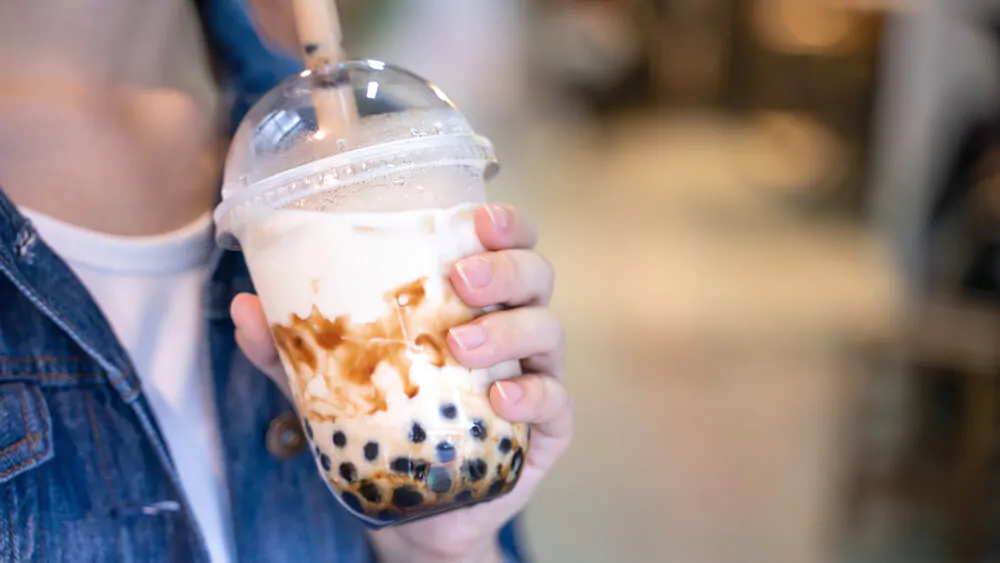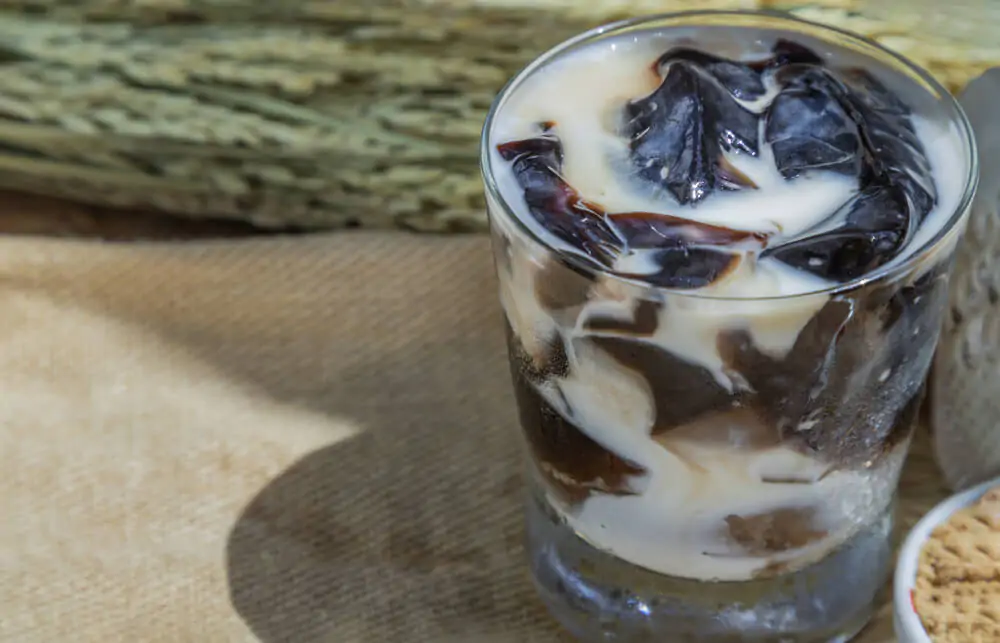If you’re obsessed with boba teas, we’ve got everything you need to know about tapioca pearls vs. jelly.

Boba drinks are growing in popularity throughout the Western world to the point that some areas even experience shortages! There’s no doubt that people from Taiwan to Los Angeles are obsessed with boba drinks or bubble tea, but there’s still confusion when it comes to the difference between tapioca pearls and jelly.
What are Tapioca Pearls and Jelly?
Tapioca pearls are traditional to boba or bubble teas. They come from the cassava root, an essentially tasteless, starchy plant. Cassava came to Taiwan, the capital of boba drinks, in the late 18th century, and over time the Taiwanese turned this seemingly boring starch into sweet pearls that lurk at the bottom of milk tea drinks.
Tapioca pearls start out essentially tasteless, just like the cassava they came from. After boiling in a vat of caramelized sugar, though, they become the delightfully springy, sweet balls we slurp from the bottom of our favorite boba teas.
Boba jelly drinks are a little different. They include jellies in various forms that have textures similar to tapioca pearls. But usually, these jellies aren’t pearl or bubble-shaped. Instead, they’re often rectangular or square.
Tapioca in powdered form acts as a thickener, and chefs often use it to make a variety of jello-like products. However, most boba jelly drinks rely on ingredients besides tapioca.
Grass jelly drinks are traditional on many boba shop menus. Grass jelly comes from a plant called Chinese Mesona. It’s dark, like tapioca, but has a bitter, herby flavor that pairs well with sweet milk teas.
There are also fruit or rainbow jelly drinks that rely on coconut milk, cornstarch, and various fruit flavors, like mango, passion fruit, or pineapple.
Then, there are coffee jelly drinks. Coffee jellies combine coffee and gelatin to create caffeinated bits that you can slurp from the bottom of your iced coffee.
What Do Tapioca Pearls and Jelly Have in Common?
Both tapioca pearls and jelly provide fun and fascinating texture to boba drinks. They’re fun to slurp through a straw, and many boba fanatics will tell you they’re downright addicting.
Tapioca pearls and jellies can also come in a variety of flavors. Though traditional tapioca pearls taste like caramelized sugar and traditional grass jellies taste herby and a little bitter, both can carry other flavors instead. Whether you want passionfruit, honey, or coffee-flavored bubble drinks, you can find them.
Tapioca Pearls vs. Jelly: The Differences
Tapioca pearls are round and made of tapioca, just like their name suggests. Jelly, on the other hand, is usually cut into small squares or rectangles. It also comes from a wider variety of ingredients.
Though powdered tapioca is sometimes used to make jelly, more often than not, jelly comes from gelatin or cornstarch and some sort of liquid. With fruit or rainbow jelly, the liquid is usually coconut water. With coffee jelly, the liquid is, of course, coffee.
In traditional grass jelly drinks, the jelly comes from Chinese Mesona, a slightly bitter, herb-like plant that’s far from tapioca.
What’s Better About Tapioca Pearls?

Tapioca pearls are traditional and fun to drink. It’s what most people expect when they order a boba or bubble tea. The pearls or bubbles slide up through the straw and delightfully pop when you chew them. The texture and shape of tapioca pearls make many people huge fans of them.
What’s Better About Jelly?
Jellies are a little newer, at least to the western world. They come in a wider variety of flavors at most shops as well. Many love slurping the long rectangular bits, and several DIY boba makers enjoy making jellies themselves.
The square shape is much more approachable than tapioca pearls. With gelatin and your choice of flavors, you can easily make them at home.
Who Should Get Tapioca Pearls?
If you want to experience boba or bubble tea in its most popular form, you’ll want to order it with tapioca pearls. That will get you a drink with the pearl-shaped pops of flavor at the bottom of the glass.
Who Should Get Jelly?

If you’re looking for the traditional grass jelly drink featuring Chinese Mesona, then you’ll want to order grass jelly boba.
Jelly drinks can also come in a variety of non-traditional flavors that you should watch out for. For example, rainbow jellies are usually fruit-flavored with mango, strawberry, passionfruit, or pineapple. Coffee jellies are delicious as well and becoming more available.
Tapioca Pearls vs. Jelly
| Tapioca Pearls | Jelly | |
| Origin | tapioca, which comes from the cassava plant. | traditionally made of Chinese Mesona, but can also be made of cornstarch, powdered tapioca, or gelatin |
| Shape | pearl or bubble-shaped | square or rectangular |
| Tastes like | traditionally tastes like caramelized sugar, but also available in fruit flavors | available in a variety of flavors, including all sorts of fruit flavors and coffee flavors |
